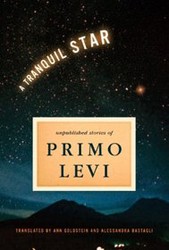This boxed set represents the culmination of a multi-year effort to bring to American readers the complete works of Italian scientist, man-of-letters, and Shoah survivor Primo Levi. Under the able editorship of Ann Goldstein, the volumes present in new translations all of Levi’s works — the early narratives of Levi’s experiences as an inmate of Auschwitz (If This Is a Man) and his Odysseus-like return trip to Italy via Russia (The Truce); his ground-breaking memoir (The Periodic Table); his late novels (The Wrench; If Not Now, When?) and his valedictory and somber reconsideration of the meaning of the Nazi extermination machine (The Drowned and the Saved), in addition to all of his occasional newspaper columns, short stories and previously uncollected essays, as well as his poetry. Levi accomplished this prodigious output in the 42 years between his liberation from Auschwitz and his premature death in 1987 (presumably by suicide); all the while he held down a series of increasingly responsible “day” jobs as a working scientist and industrial manager.
Levi’s work gained American attention only in the last few years before his death, nearly 40 years after he first began writing. His early memoir, If This Is a Man, was not published in English until 12 years after its first Italian publication in 1947 and did not garner much attention. Likewise, the translation of The Truce (published in the U.S. under the title The Reawakening), written years after the events depicted, was also neglected. It was not until endorsements by Irving Howe and Saul Bellow of The Periodic Table in the early 1980s generated interest that Levi entered the consciousness of the American reading public.
Seventy years after the liberation of the camps and the proliferation of survivors’ accounts and scholarly and creative works on the Shoah, If This Is a Man still horrifies with its accumulation of details of the squalor and degradation, the daily humiliations, the petty rules, the viciousness of camp inmates toward each other, the arbitrary judgments of the SS guards and their prisoner-Kapo assistants “selecting” inmates for extermination, and the sheer brutality of the work inflicted on those who were not immediately consigned to the death chambers. Levi considers that it was his “good fortune” to be sent to Auschwitz so late in the war (he was captured in a raid on his partisan band in January 1944) and he credits his survival in the most notorious of the Nazi death camps to a combination of fortuitous circumstances. What is also striking about the narrative is its almost complete absence of anger, rancor, or judgment about the perpetrators of this epitome of human evil. Levi thus gained the reputation of being a secular saint, a Christ-like dispenser of forgiveness, a characterization he most emphatically rejected. As he made clear years later in an appendix added to the republication of the volume for school use, his inclination to hatred toward his oppressors was tempered by his rational quest for justice above all. He felt he would be more credible if he “assumed the calm and sober language of the witness, not the lament of the victim or the anger of the avenger.” This “calm and sober” demeanor carries over into his later, more probing analysis in The Drowned and the Saved, which offers a scathing but rational and measured critique of the active participants in the “Final Solution” and their silent and passive accomplices. In that later book, he is unsparing but also understanding in his consideration of the psychology of the victims, those caught in what he calls “the grey zone” of the camps.
Levi’s narrative of his delayed homecoming in The Truce is another order of narrative— more picaresque and occasionally almost comic in tone — that opens up with a skill equal to If This Is a Man the less frequently depicted post-liberation struggle for survival. Liberated from the abandoned Auschwitz by advancing Russian troops, Levi was sent on a nine-month odyssey through Poland and Ukraine, with a return journey through most of war-devastated Eastern Europe. The book is filled with heartbreaking depictions of deprivation and near-anarchy, leavened somewhat by the colorful characters Levi encounters. This experience served as Levi’s inspiration for his later effort at extended fiction, his self-described “Western,” If Not Now, When?, which traces the activities over a three-year period of a band of Russian-Polish-Jewish partisans as they seek to hide out from and disrupt the Nazi war effort in Eastern Europe, and their eventual arrival in Italy en route to a new life in Palestine.
The Periodic Table is Levi’s most popular book. Its unusual hybrid quality is perhaps the secret to its success but also its most challenging aspect. Levi’s use of the periodic table as a metaphor or analogy for aspects of his life before and after his imprisonment is often hard to interpret, but the book succeeds in a number of strong vignettes; perhaps the most striking is the penultimate chapter in which Levi, in his role as manager of a paint factory, corresponds with a German scientist who, it turns out, was involved in the I. G. Farben synthetic rubber project on which Levi worked at Auschwitz and to which he attributed his survival. Levi later revealed that this character, Dr. Müller, was a composite, but the vignette encapsulates the mentality that Levi sees as supporting the Nazi death machine through deliberate ignorance of the horror being perpetrated right under witnesses’ noses and the blinkered refusal to accept moral responsibility in the aftermath.
Ann Goldstein, the general editor of these volumes, asserts that it is somewhat unfortunate that Levi is identified primarily as a Holocaust writer (Levi himself did not like the term Holocaust), and she tries to make a case for the extensiveness of his output and the variety of his subjects. To this reader, the non-Holocaust related pieces — the large numbers of quasi-science fiction pieces and occasional essays collected here — seem of less consequence than the major narratives. The science fiction stories are amusing exercises in a kind of writing reminiscent of Ray Bradbury, Jorge Luis Borges, or Levi’s Italian contemporary Italo Calvino. The poetry is heart-felt and penetrating, often, as Jonathan Galassi suggests, breaking through to deeper emotions that Levi kept bottled up in his prose. The occasional essays, many of them comments on the Shoah, were often recycled by Levi into his later Drowned and Saved, so there is some degree of repetition if one reads the entire contents of this massive collection.
The distinctive feature of this collection is the new translations of all the works with the exception of If This Is a Man, which appears in a revised version by its original translator, Stuart Woolf. In addition to Goldstein and Woolf, translators include Nathaniel Rich (The Wrench); Jenny McPhee; Jonathan Galassi (Levi’s poetry); Anne M. Appel; Antony Shugaar; Michael Moore; and Alessandra and Francesco Bastagli. All read smoothly and capture Levi’s restrained tone and style. The lack of an extended discussion beyond Goldstein’s introduction of the issues involved in the translations seems an unfortunate omission. In addition to the essays on Levi’s reputation in Europe and the U.S., the volumes also contain commentary and notes on the individual works that detail their publication histories and put them into the context of Levi’s life.
As Toni Morrison eloquently puts it in her brief introduction, in reading Levi, “Time and time again we are moved by his narratives of how men refuse erasure.” This is Levi’s legacy and these volumes solidify it.
Bibliography, notes; commentary
Related Content:
- Nicholas Kulish: What’s a Nazi?
- Diary of the Fall by Michel Laub



